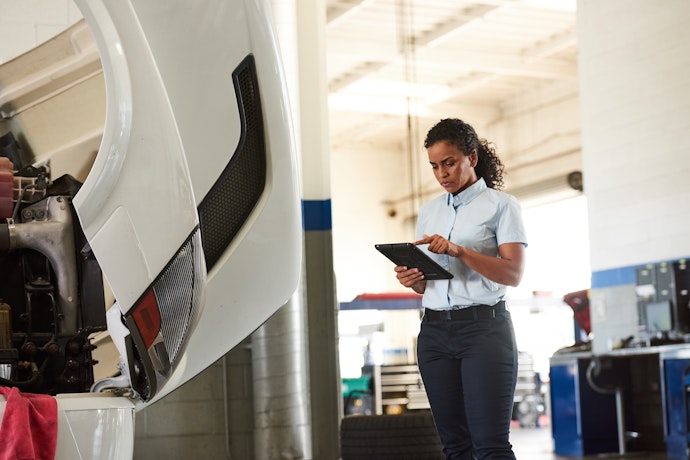How smart video fuels smart business
Learn how innovations in video powered by AI and machine learning are helping to reshape safety and efficiency.
Read more
July 11, 2019
Pre-trip vehicle inspections are one of the most important factors in ensuring the safety of CDL drivers and vehicles. A skipped or hastily performed CDL pre-trip inspection could lead to a catastrophic crash with injuries and fatalities.
The FMCSA Driver Vehicle Inspection Report (DVIR) requirements state that drivers must inspect a vehicle and confirm that any needed repairs from the previous DVIR have been performed prior to using it. The mandate states that before driving a motor vehicle, the driver shall:
(a) Be satisfied that the motor vehicle is in safe operating condition;
(b) Review the last driver vehicle inspection report; and
(c) Sign the report, only if defects or deficiencies were noted by the driver who prepared the report, to acknowledge that the driver has reviewed it and that there is a certification that the required repairs have been performed.1
Improving the pre-trip inspection process has many safety benefits, but some fleet managers don’t properly communicate the critical importance of performing DOT pre-trip inspections. Below are three essential rules that can improve the approach your organization takes to pre-trip inspections and organizational safety.
Truck drivers come from many backgrounds, and their previous policy/procedures may have been lax. Never assume that your drivers know the correct way to perform an inspection. Proper training is essential for every driver in your fleet—regardless of age or safety history.
All drivers should be provided a training guide with imagery and case studies for pre-and post-trip inspections. Give drivers a comprehensive list of potential risks for failing to complete an inspection and have them sign off on it, indicating that they understand the consequences.
Be sure to communicate openly and give drivers all of the necessary details. For example, drivers need to know who to go to when they find out a repair from the previous day DVIR has not been completed and what to do about it. They also need to know exactly what they should be checking during each and every inspection, including:
Fleet managers can incorporate best practices for pre-trip inspections into your organization’s safety culture efforts. According to the DOT, when safety culture is strong, accidents are less frequent and less severe.2
Driver behavior can be monitored using telematics software that shows how frequently a driver engages in speeding, hard braking, harsh acceleration, seat belt use and more. Fleet managers are notified of any incidents in real time so measures can be taken. Drivers also receive a scorecard of their driving behaviors, making it easy to identify areas for improvement and encourage better habits. Using scorecards, managers can set company benchmarks and individual drivers can try to meet or surpass expectations. If drivers know that safe driving behavior is monitored and rewarded, they’ll be less likely to take risks with their pre-trip inspections.
When leadership is clearly dedicated to safety culture, individual employees begin to feel personally responsible for preventing accidents. The more often drivers hear about the importance of safety, the more likely they are to engage safe behaviors.
Document a company policy for pre-trip inspections and communicate the expectations of that policy clearly and often throughout your organization. Enforcement of the process at all levels is critical as it contributes to safety culture development through all levels of a company.
Electronic DVIRs establish and enforce a standard driver procedure for pre-trip inspections. DVIRs can be completed using a smartphone or tablet with features that force drivers to physically inspect the vehicle rather than just speeding through the form. Some benefits of going electronic include:
Follow these three rules and your organization should be able to establish a culture of safety and improve all pre-trip inspections. Safety-conscious organizations are likely to have lower Compliance, Safety, Accountability (CSA) scores, fewer DOT roadside inspections, lower insurance premiums, and overall higher bottom lines.
Sources
1 https://www.ecfr.gov/cgi-bin/retrieveECFR?gp=1&ty=HTML&h=L&mc=true&=PART&n=pt49.5.396#se49.5.396_113
2 https://rosap.ntl.bts.gov/view/dot/32538/dot_32538_DS1.pdf
Tags: ELD & Compliance, Inspections, Performance & Coaching, Safety, Vehicle Maintenance




Find out how our platform gives you the visibility you need to get more done.
Learn how innovations in video powered by AI and machine learning are helping to reshape safety and efficiency.
Read moreAre you ready for vehicle tracking? Go through our checklist to learn the signs you’re ready to add fleet tracking to...
Read moreLearn how AI, machine learning, and predictive analytics is improving fleet accurating and cutting costs.
Read moreLearn how telematics can lead to operational improvements.
Read more